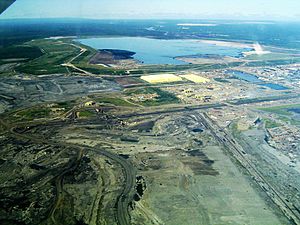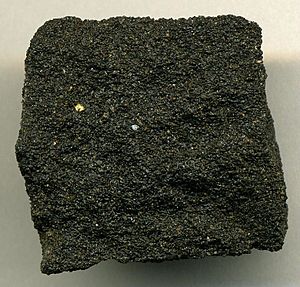Oil sands facts for kids
Oil sands, or tar sands are an unconventional source of petroleum. The oil sands are a mixture of sand, clay and water together with a dense and extremely sticky form of petroleum referred to as bitumen.
Natural bitumen is found in many countries, with the largest quantities in Canada, Kazakhstan and Russia. The estimated worldwide deposits are more than 2 trillion barrels (320 billion cubic metres). These estimates include deposits that have not yet been discovered. Around 70% of all proven reserves are in Canada.
Oil produced from bitumen sands is often referred to as unconventional oil, to separate it from traditional liquid oil. The production process is very energy consuming so that the net energy gain is much smaller compared to traditional oil. Making liquid fuels from oil sands requires much energy and produces 12 percent more greenhouse gases per barrel of final product than production of traditional oil. Therefore oil sands have only recently been considered to be part of the world's oil reserves. Higher oil prices now allow for profitable extraction and processing.
Environmental issues

Getting the oil sands off the ground often destroys large areas of land. Much water is used to separate the oil from the sand and then left polluted. Carbon dioxide and other emissions from the extraction process are polluting the air. The environmental destruction caused by oil sand extraction is criticized by environmental groups such as Greenpeace, The Climate Reality Project, 350.org, MoveOn.org, the Sierra Club and the Energy Action Coalition.
In 2012 the European Union (EU) said that it may declare oil sands oil as "highly polluting". This caused stress between the EU and Canada.
Related pages
Images for kids
-
Demonstration of citizens against tar sands and the Keystone Pipeline.
See also
 In Spanish: Arenas petrolíferas para niños
In Spanish: Arenas petrolíferas para niños








